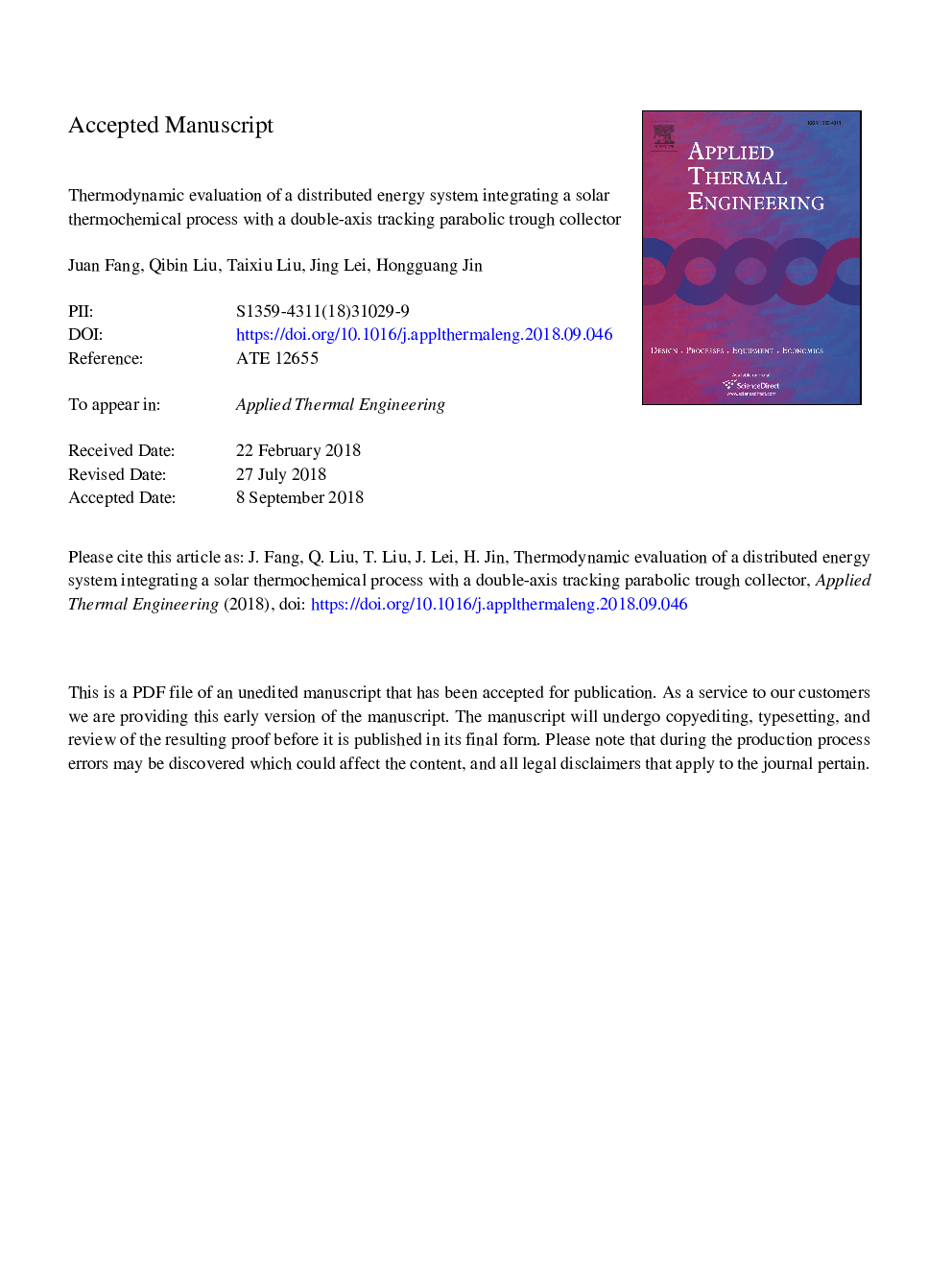| کد مقاله | کد نشریه | سال انتشار | مقاله انگلیسی | نسخه تمام متن |
|---|---|---|---|---|
| 11027955 | 1666144 | 2018 | 40 صفحه PDF | دانلود رایگان |
عنوان انگلیسی مقاله ISI
Thermodynamic evaluation of a distributed energy system integrating a solar thermochemical process with a double-axis tracking parabolic trough collector
ترجمه فارسی عنوان
ارزیابی ترمودینامیکی یک سیستم انرژی توزیع شده که یک فرایند شیمیایی حرارتی خورشیدی را با یک جمع کننده پارابولیکی ردیابی دو محوره
دانلود مقاله + سفارش ترجمه
دانلود مقاله ISI انگلیسی
رایگان برای ایرانیان
کلمات کلیدی
ترجمه چکیده
یک سیستم جدید توزیع شده انرژی که یک فرایند شیمیایی حرارتی خورشیدی را با یک جمع کننده پارابولیک ردیابی دو محوری به کار می برد، پیشنهاد شده است تا به چالش های موجود در بازه های فصلی بازده خورشیدی به سوخت و استفاده ناکافی از انرژی خورشیدی در خروج از سیستم های انرژی توزیع بپردازد. انرژی خورشیدی متلاشی شده با انرژی کم انرژی به وسیله فرایند شیمیایی خورشیدی، که به راحتی قابل ذخیره است، به انرژی شیمیایی همگام گاز افزوده می شود. جمع کننده دیافراگم ردیابی دو محوری به فرآیند حرارتی خورشیدی به منظور حذف کامل کسینوس به منظور افزایش کارایی ترمودینامیکی سالانه به کار می رود. با در نظر گرفتن تنوع انرژی خورشیدی، اتصال بین بارهای کاربر و خروجی های انرژی در سیستم پیشنهادی مورد بررسی قرار می گیرد و عملکرد مطلوب طراحی و ترمو شیمیائی طراحی شده و خارج از طراحی از لحاظ عددی تایید می شود. نتایج نشان می دهد که تولید سوخت خورشیدی و تولید برق خورشیدی در سیستم پیشنهادی در مقایسه با سیستم مرجع حدود 27 درصد در سال افزایش می یابد.
موضوعات مرتبط
مهندسی و علوم پایه
مهندسی شیمی
جریان سیال و فرایندهای انتقال
چکیده انگلیسی
A new distributed energy system integrating a solar thermochemical process with a double-axis tracking parabolic trough collector is proposed to address the challenges on large seasonal variations of solar-to-fuel efficiency and insufficient utilization of solar energy in exiting distributed energy systems. Low-energy level discontinuous solar energy is upgraded into the chemical energy of syngas via the solar thermochemical process, which is easy to be stored. The double-axis tracking parabolic trough collector is deployed to the solar thermochemical process to eliminate the cosine loss completely to increase the annual thermodynamic efficiency. With the consideration of the variation of solar energy, the coupling between user's loads and energy outputs in the proposed system is investigated, and the favorable on-design and off-design thermochemical performances are numerically validated. Results indicate that the solar fuel production and the solar power production in the proposed system increase approximately 27% annually as compared with the reference system.
ناشر
Database: Elsevier - ScienceDirect (ساینس دایرکت)
Journal: Applied Thermal Engineering - Volume 145, 25 December 2018, Pages 541-551
Journal: Applied Thermal Engineering - Volume 145, 25 December 2018, Pages 541-551
نویسندگان
Juan Fang, Qibin Liu, Taixiu Liu, Jing Lei, Hongguang Jin,
